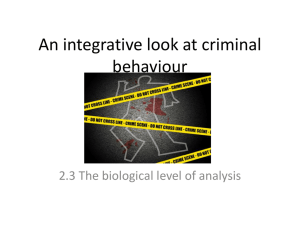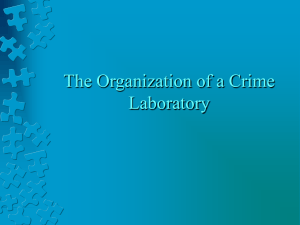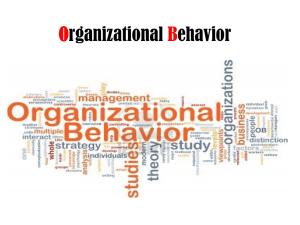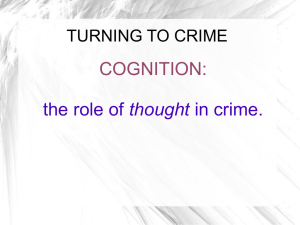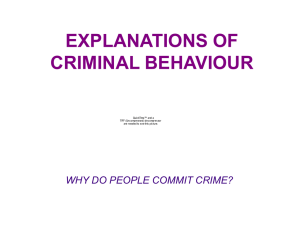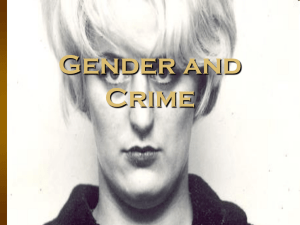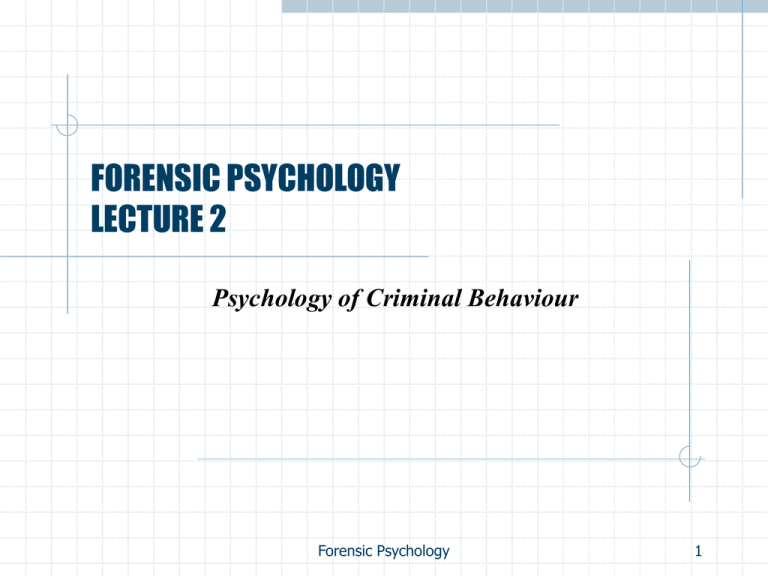
FORENSIC PSYCHOLOGY
LECTURE 2
Psychology of Criminal Behaviour
Forensic Psychology
1
Recommended Reading
Howitt, Dennis. (2009), Introduction to Forensic and Criminal
Psychology: 3rd Edition. London: Pearson Prentice Hall – Chapter 5.
Hollin, C.R. (1989), Psychology and Crime: An Introduction to
Criminological Psychology. London: Falmer Press.
Hollin, C.R. (1992), Criminal Behaviour: A Psychological Approach
to Explanation and Prevention. London: Falmer Press.
Millon, Theodore; Simonsen, Erik; Birket-Smith, Morten; and Davis,
Roger D. (1998), Psychopathy: Antisocial, Criminal and Violent
Behaviour. New York: Guilford – Chapter 3, Chapter 8.
Forensic Psychology
2
Aims of Lecture
Examine the root causes of crime.
Describe the biological perspectives on criminal behaviour.
Describe the sociological theories on criminal behaviour.
Evaluate psychological perspectives on crime.
Forensic Psychology
3
Theories of Crime
• Societal or macro-level theories study crime at a broad level of analysis and
suggest that crime is purely as a result of social structure.
• Community or locality theories study crime form a geographical perspective.
Suggests that crime or criminality is not randomly distributed – geographical
profiling.
• Group and Socialisation Influence Theories focus on criminal behaviour and
concentrate on the influence of the group (family, sociological perspective of
group thinking.
• Individual approaches study crime at an individual level. Individual
characteristics are linked to biological and social influences.
Forensic Psychology
4
Psychoanlytic Theory
Instinctual theories hold with the idea that aggression is an innate,
instinctual behaviour, (“Lord of the Flies”).
Freud’s psychoanalytic approach (1930’s) suggests that aggression is
an underlying urge that must be expressed. He sees aggression as
innate and inevitable, even to the point of the tendency towards death
or the “death instinct” (Thanatos). Freud argues that it is important for
the individual to direct this energy outwardly. Both Freudian and
ethological viewpoints emphasize the importance of “catharsis”, where
the aggressive drive must find an outlet in actual aggressive behaviour
or in some symbolic substitute.
Bowlby: (1944-1980) Emotional bond between child and mother
“44 juvenile thieves” study – 14 of the 44 “affectionless characters”
Forensic Psychology
5
Explaining Crime - Biological Theories
Biological Theories explain criminal behaviour in terms of genetic forces
rather than free will – proposal that behaviour is determined by genes.
Historical explanation proposed by Lombroso – 19th century Italian
physician Lombroso discussed “criminal types” – identified by
physical characteristics such as excessive hair, long ear lobes, large jaw
and slanting forehead – throwbacks to an earlier more primitive form of
man – later incorporated psychological and environmental variables in his
research. Modern theory moves away from the “criminal gene”.
FAMILY STUDIES
Twin Studies
Adoption Studies
Forensic Psychology
6
Sheldon’s Constitutional Theory
Sheldon’s Constitutional Theory (1942) – body build and
personality 3 different body types (somatypes)
Mesomorphs, (muscular) – adventurous, aggressive – mainly the
criminals.
Ectomorph (thin and bony) – restrained, introverted.
Endomorph (large and heavy – sociable and outgoing
(Biology and Psychology)
Forensic Psychology
7
Twin Studies
TWIN STUDIES
Monozygotic (MZ) – identical – same genetic constitution
Dizygotic (DZ) – share about 50 % of genetic constitution.
If twins are in same environment – assumed differences must be due to
genetic variation. Concordance – the degree to which related pairs of subjects
within a study population display the same behaviour.
Number of Studies have shown higher concordance in MZ twins (See
Table overleaf)
The study of criminal behaviour in twins reared apart is limited.
Twins may be treated differently.
Forensic Psychology
8
Twin Studies
Study
Criminal
Behaviour
of
MZ
DZ
Number of
Pairs
%
Concordant
Number of
Pairs
%
Concordant
Lange (1929)
13
77
17
12
Rosanoff (1934)
37
68
60
10
Yoshimosu
(1965)
28
50
26
0
Christianson
(1977)
85
32
147
12
Forensic Psychology
9
Adoption Studies
Approach involves tracing children who have been given up for
adoption, and comparing their criminal records with that of the
biological and adoptive parents.
Mednick, Gabrielli & Hutchings Study (1983- 1984)
4,000 male adoptees – enough information on parents to assess potential
contribution of criminality.
Compared the criminal behaviour of the children with that of their biological and
adopted parents.
Criminal behaviour of biological parents had stronger influence than that of the
adoptive parents (property offences – not violent crime)
Forensic Psychology
10
Male Adoptees With Criminal Records According to Criminality of Parents
Adoptive
Parents
Biological Parents
Criminal
Non-|Criminal
Criminal
24.5%
(N=143)
14.7%
(N=204)
Non-criminal
20%
(N=1,226)
13.5%
(N=2,492)
Forensic Psychology
11
Biology and Crime
Neurological theories Hillbrand et al (1998) – higher levels of enzyme
serem creatine kinase
Raine (1994) – Murderers had significant lower glucose metabolism in
both lateral and medial prefrontal cortex areas – says that deficits were
localized in the frontal cortex may be related to violence.
Millar (1999) physiological characteristics may be a s result of
institutionalization rather than cause of criminality
All demonstrate that genetic factors do have a role to play in the
explanation of crime.
Forensic Psychology
12
Explaining Crime – Sociological Theories
Mountjoy Prison Study – “Typical” Irish Criminal?
Durkeim suggests that a certain amount of crime and non-conformity
is needed in a society to help reinforce social values – a small number
of criminals reinforce other’s values - if society was all conforming, it
might stagnate.
Merton’s “Strain Theory” – (1969) – suggests working class people
are more prone to commit crimes – ultimate goal is to gain material
success and criminals conform to the core values of the culture (or
lower class social groups). The only way they are different is the
methods they use. Why the working class? – because they have fewer
chances of achieving material success than those that are better off.
Forensic Psychology
13
Explaining Crime – Sociological Theories
• Marxists study crime in relation to the inequality of power – the basic idea is
that the law exists to protect the ruling class and keep the working class under
control – I.e. the haves and the have nots.
• Beckers (1963) – “Labeling Theory” – deviant behaviour is behaviour that
people so label. The people that hold power label the “criminal” – may become
a self-fulfilling prophesy I.e.mental illness, terrorists. Stigma/Martyr.
• Bowlby - explains deviance in terms of a child’s socialisation process –
maternal deprivation might result in a criminal or psychopathic nature in later
life.
• Lykken – “The Case for Parental Licensure” – Chapter 8, Millon et al.
Forensic Psychology
14
Personality and Criminal Behaviour
HANS J. EYSENCK – PERSONALITY AND CRIME.
• Theory incorporates biological, sociological and psychological factors.
• Proposes three personality dimensions of extraversion, neuroticism and
psychoticism.
• Eysenck’s theory of personality and crime examines the causal problem.
• Conscience is a conditioned response acquired through Pavolovian principles.
We are punished or rewarded by our parents, teachers, and peers for our social
behaviour (conditioning experience) in our conscience.– we behave well
because our consciences would trouble us if we didn’t.
Forensic Psychology
15
Personality and Criminal Behaviour
Eysenck & Eysenck (1985) – 3 major dimensions of personality - Continuum
P – Psychoticism – ( Aggressive, cold, impulsive, etc.)
E – Extraversion – (Sociable, assertive, carefree, etc.)
N – Neuroticism – (Anxious, depressed, irrational)
Different combinations of personality scores are linked to criminal behaviour at
different periods during life, but high psychoticism levels distinguishes between
criminal and non criminals.
Forensic Psychology
16
Eysenck – Personality and Crime
CRIMINAL BEHAVIOUR IS A RESULT OF
Missing Conditioning Experiences
Wrong Experiences are Reinforced
Poor Conditionability - Raine (1993) – Anti-social people and criminals show
poor conditionability (speed at which they form Conditioned Responses)
Cortical and Autonomic Nervous System we are born with affects our ability to
learn from or condition to the environment.
Cortical arousal – low arousal makes conditioning less likely to occur
P – Poor/Low arousal – Always involved
E – Poor/Low arousal – Younger samples – seeking stimulation
N – Normal arousal – Older samples - – emotion and anxiety
Forensic Psychology
17
Other Factors
Alcohol
Drugs
Anti Social Personality Disorder
Psychopathy
Cognitive Theories
Addiction to Crime
Poverty
Unemployment
Criminal Justice System
Policing
Legislation
Societal responses
Sentencing Policies
Etc……………………………………………………………………………..
Forensic Psychology
18


